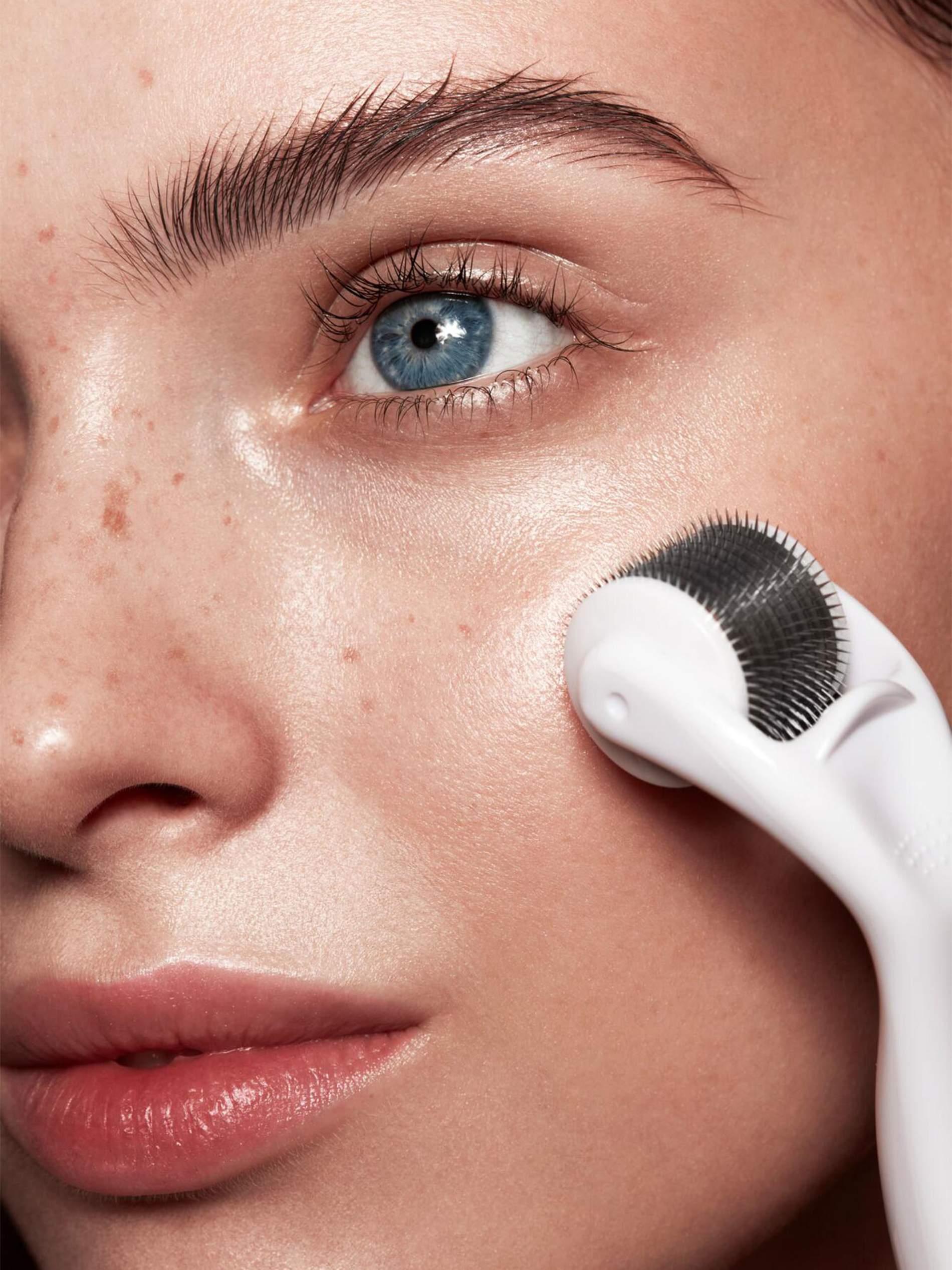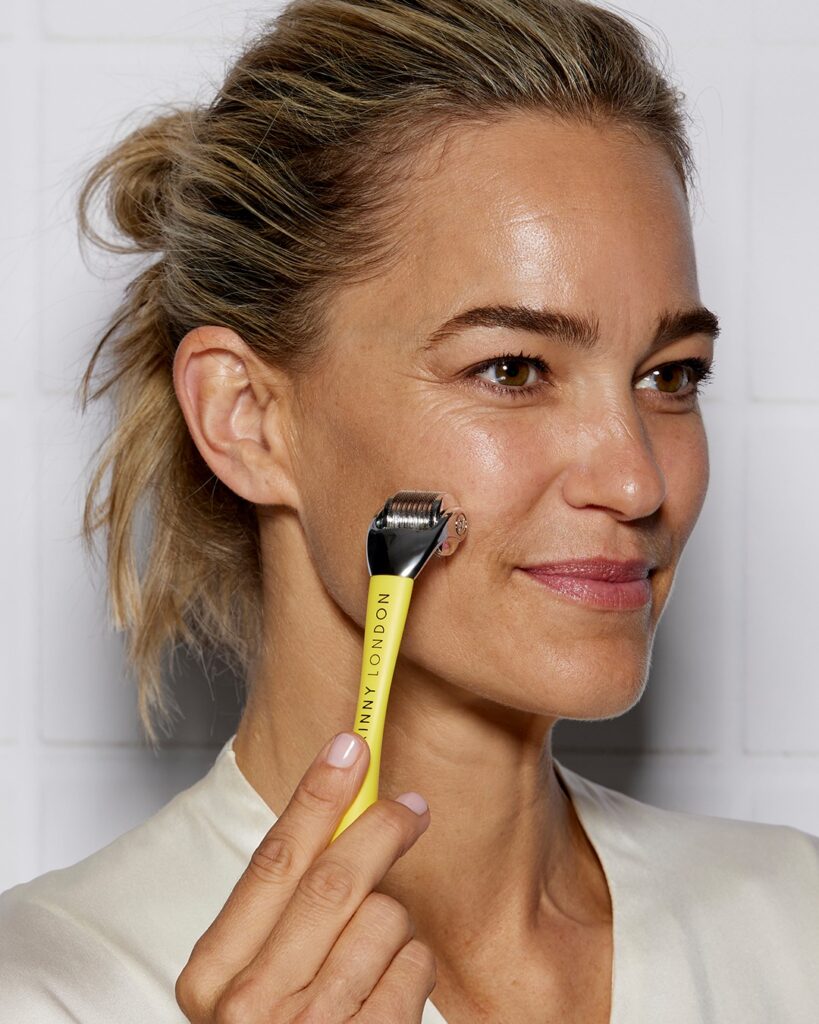
Some things, (three-martini hangovers, eating a tub of Ben and Jerry’s in your dressing gown, failing to master a Yoga With Adrienne pose…) are best performed in your own home. Others (appendectomies, dentistry, invasive cosmetic procedures) are best performed in a clinical setting. Or at least, that was the old way of thinking. These days, more and more of us are embracing a can-do attitude. Though not to appendectomies, hopefully. The DIY revolution, driven by the pandemic and social media, has democratised processes such as tooth whitening, gel manicures, dermaplaning and at-home microneedling.
But isn’t sticking a bunch of needles in one’s face, no matter how ‘micro’, best left to the pros? And why would anyone want to do that anyway? If you’re asking yourself these questions, then read on, as GRAZIA tapped a leading plastic surgeon, dermatologist and aesthetician to demystify the at-home microneedling process.
What is microneedling?
“Microneedling is a well-established treatment used for a variety of conditions, including the treatment of fine lines, enlarged pores, acne scarring, burns scar treatment and for achieving a general improvement in the condition of the skin itself,” explains Dr. Georgina Williams, Consultant Plastic and Reconstructive Surgeon and Co-Founder of Montrose. “There are numerous devices for microneedling. These include things such as dermarollers which, as the name suggests, involves needles on a roller which can be passed over the face.”
How does it work?
“The mechanism behind microneedling lies in its ability to promote collagen induction therapy,” Dr. Yulia Krasnaya, Dermatologist & Medical Director at Dubai’s Evolution Aesthetic Clinic, tells us. “As the micro-injuries are created, the body perceives them as minor wounds and initiates the healing process by increasing blood flow to the area and producing new collagen and elastin fibres. This leads to the formation of new, healthier skin tissue, resulting in improved texture, tone, and overall appearance.” What’s more, these itty-bitty injuries create a channel to the deepest layers of layers of the skin, meaning that all those skincare ingredients we bang on about so much, such as hyaluronic and glycolic acid, will be working from the inside out.

Should we be doing microneedling at home?
That depends. The DIY method – as facilitated by devices such as the brushworks HD Dermaroller or the Faceshot by FaceGym, which delivers a brightening dose of glycolic acid as it goes on its merry way, is undoubtedly cheaper and more convenient, but the risks don’t necessarily outweigh the rewards.
For one thing, the at-home devices aren’t quite as effective, as they have shorter needles than those used in professional settings, as Emma Wedgewood, Aesthetician and founder of Emma Wedgewood Aesthetics, reveals. “Microneedling performed by a trained medical professional in a clinic is generally considered safer and more effective. Professional microneedling devices are engineered to penetrate the skin at varying depths. Unlike cosmetic alternatives, these medical-grade devices can reach deeper layers of the skin, enabling more intensive and targeted treatments for enhanced outcome.”
The risks of scarring is drastically reduced in a clinic setting, says Dr Williams. “By using sterile. single-use devices, you reduce the risk of infection”, she says. “There is also a risk of scarring, if performed incorrectly. You also really need a practitioner to confirm that your skin is appropriate for the procedure. There are some individuals who cannot have it, there are some individuals who should avoid the treatment, for example, people who have psoriasis, eczema, active acne, or who are on some oral medications for acne such as Roaccutane.”
“Choosing a reputable clinic and experienced practitioner is crucial,” says Dr. Krasnaya.“Research clinics and practitioners with a track record of safety and success in performing microneedling treatments. Before the procedure, it’s important to follow pre-treatment instructions provided by your practitioner. This may include specific skincare preparations such as avoiding sun exposure and certain products to optimise the outcome.”
And if you simply must DIY…
“Using a high-quality device is crucial for safety and effectiveness,” says Emma Wedgewood. “Following the manufacturer’s instructions for proper use and maintenance can help you achieve the best results while minimising the risk of complications.” And sterile means sterile! “It is imperative to ensure that the needles used are sterile and designated for single use only. In the case of a dermal roller, it should not be reused unless it undergoes rigorous disinfection processes.”
Before starting the procedure, cleanse, cleanse, cleanse to the gods! Removing dirt, makeup and oil is essential to help prepare your skin.
Afterwards, “I would recommend applying a soothing mask, serum or moisturiser to hydrate and protect the skin,” Wedgewood says. “The microchannels created in the skin remain open for a few hours, facilitating enhanced penetration of topical products. This window allows for products to reach deeper layers of the skin than under normal conditions, effectively supercharging them.”
Make sure you diligently apply the SPF 50 we should all be wearing every day. Your skin will be vulnerable to damage from UV radiation post-procedure.
Lastly, “It’s important to be patient and consistent with your treatment,” says Dr Krasnaya. “While microneedling can show noticeable improvements in skin texture and appearance, results may take time to fully manifest. Consistency with treatment sessions and adherence to skincare recommendations can help maximise benefits over time.”
Our verdict
Even the nerdiest of skincare hobbyists will have to swot up before they rise to the challenge of at-home microneedling. If you can afford to go in-clinic, do so. Otherwise, be diligent, and patient, as the effects will be harder-won.








